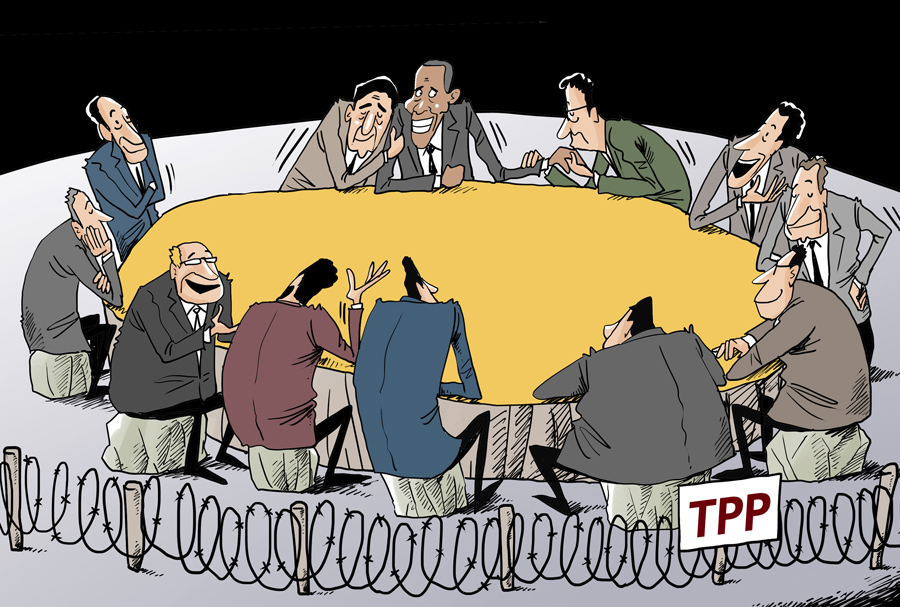ZHANG XIN: Global trade agreement should be met with reform

Formally launched in March 2010, the TPP negotiations were the subject of a fierce debate that lasted for five years.
The Trans-Pacific Partnership Agreement (TPP) follows the trends in global trade. The US will be unsuccessful if it attempts to confront or contain China through the TPP. China actively applies pragmatism and an open attitude to the process of economic globalization and regional integration. The TPP accords with China’s structural adjustment and reform, providing a powerful impetus for deepening reform and boosting development.
Not initiated by US
The TPP was not initiated by the US. It can be traced back to the Trans-Pacific Strategic Economic Partnership Agreement (TPSEP) signed by Chile, New Zealand, Singapore and Brunei in May, 2005, which was an cooperative agreement concerning such fields as goods, services, trade of intellectual property and investment.
The US participated in and dominated the negotiation of this agreement in 2008. Involving 12 member states, including Australia, Peru, Malaysia, Vietnam, Japan, Mexico and Canada, the Trans-Pacific Partnership Agreement ultimately came into being. Formally launched in March 2010, the TPP negotiations were the subject of a fierce debate that lasted for five years. The US Congress passed Trade Promotion Authority (TPA) in June 2015 to reduce uncertainty and the time spent negotiating the agreement.
Obvious intention
The TPP has inevitably been politicized in the context of international economic and political relations. The US values the TPP as an important step in its “pivot to Asia.” Dominated by the US, the TPP not only lacks transparency but also goes against the principles of free trade and cooperation. The TPP contains problematic provisions, such as government procurement agreements as well as financial liberalization, freedom of information and restriction on privileges for state-owned enterprises.
These provisions have all surpassed the current development stage and bearing capacity of developing countries like China and may not bring about the same dividends to each country.
Many countries including China, the second-biggest economy in the world, are excluded from the TPP through “high-standard new trade rules.” The TPP shows that the US intends to restrain other countries using the rules of developed economies under the banner of free trade. The US aims to safeguard its own financial capital and intellectual property advantages as well as the interests of its multinational companies in response to China’s increasing influence in the Asia-Pacific region.
Active response
China is excluded from the TPP and not likely to join the agreement in the near future. The potential pressure can motivate China to reform and tap into new development opportunities, thus facilitating its economic transformation and development.
First, “high-standard new trade rules” conform to China’s economic structure adjustment and the direction of the reform, providing the impetus for changing the development mode. It is calculated that the contribution of China’s investment to national economic growth over the past 30 years reached up to 50 percent while that of consumption was only 10 percent. The contribution of consumption and investment to economic growth can be increased to compensate for the influence of reduced exports on economic growth through such measures as improving residents’ income and social insurance, safeguarding consumer safety, and increasing investment to aspects related to people’s livelihoods, including transportation, urbanization, environmental management and health care.
Second, construction of domestic free trade zones (FTZs) and international bilateral, multilateral FTZs will be enhanced to strengthen the nation’s flexibility in response to the TPP. China established the Shanghai FTZ two years ago in anticipation of the adoption of the TPP. Additionally, from 2008 to June, 2015, China signed free trade agreements with New Zealand, Peru, Chile, Singapore and Australia, accounting for nearly half of the TPP member states. China has not signed agreements with Brunei and Malaysia, but both are members of ASEAN, which earlier signed an agreement with China. The China-Japan-South Korea FTA, China-Canada FTA and China-US Bilateral Investment Treaty(BIT) are all in negotiation. China has also pushed forward the negotiation of such agreements as ASEAN 10 plus 1, which includes 10 ASEAN countries plus China, and ASEAN 10 plus 3, which includes 10 ASEAN countries plus China, Japan and South Korea, as well as the Regional Comprehensive Economic Partnership (RECP) and the Free Trade Area of the Asia-Pacific (FTAAP).
Third, China has become a big manufacturing country with enormous production capacity and market potential. China, whose total trade accounts for more than 10 percent of the volume of global trade, is the biggest trading partner of Japan, Australia, Singapore and Vietnam, and the second-biggest partner of the US and Canada. If the TPP works, China’s exports may fall, but the decline in imports will be greater. Many countries will therefore lose market share in China. This will not conform to the interests of these countries and their enterprises. That is an important reason why China holds an open attitude to the rules that follows the trends toward global trade development and constructing a system to advance free trade.
Zhang Xin is from the School of Economics and Management at Tongji University in Shanghai.
